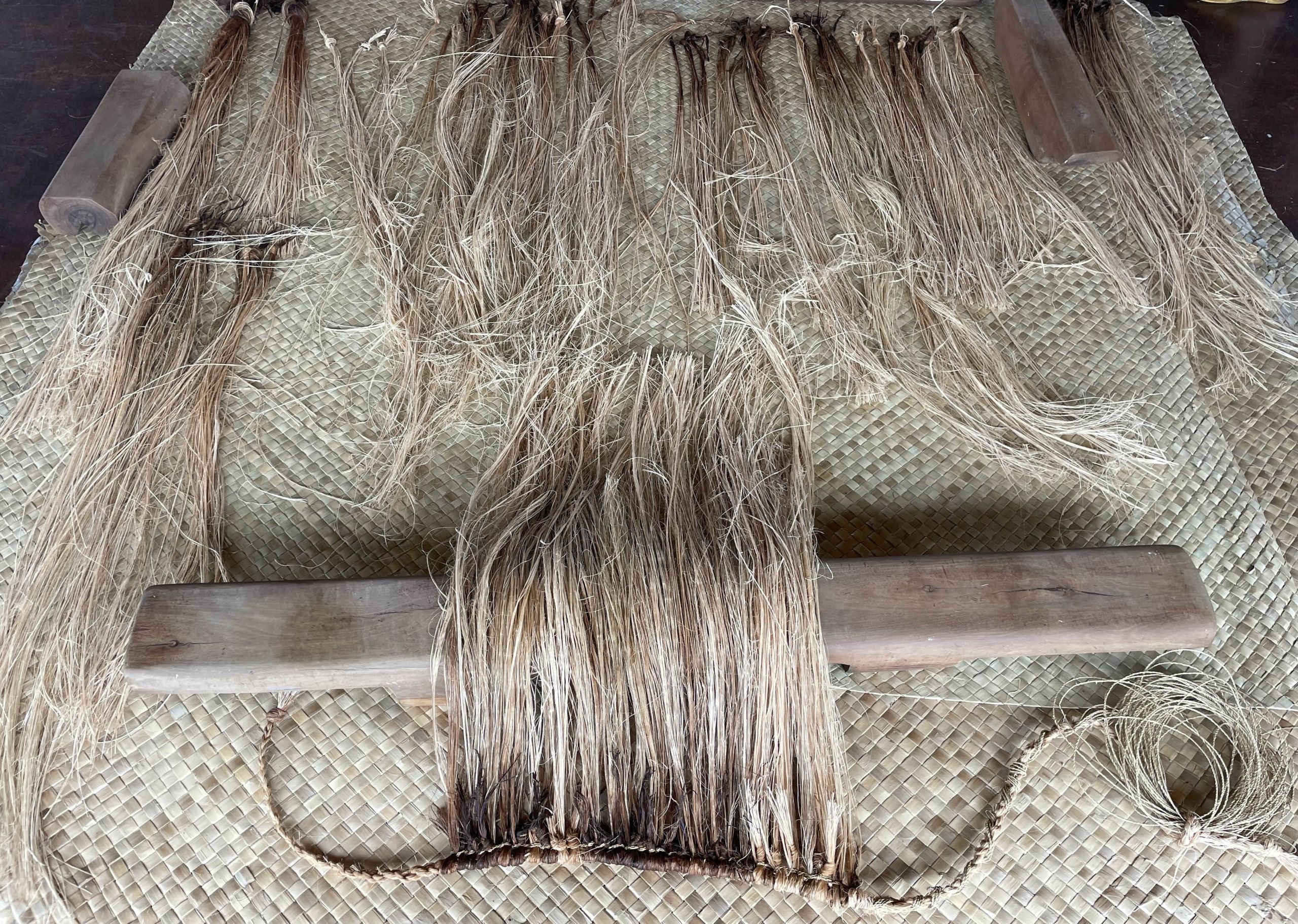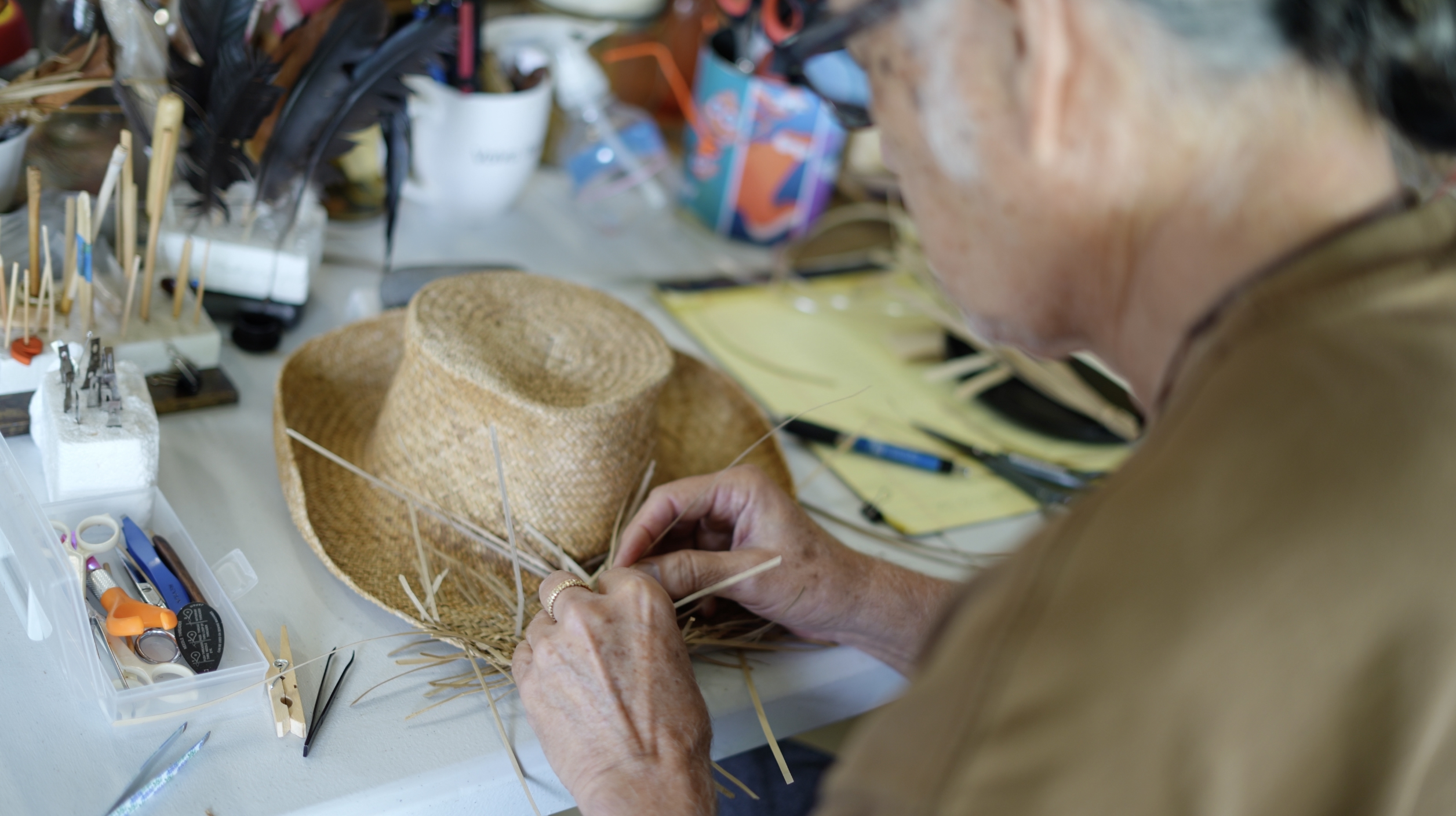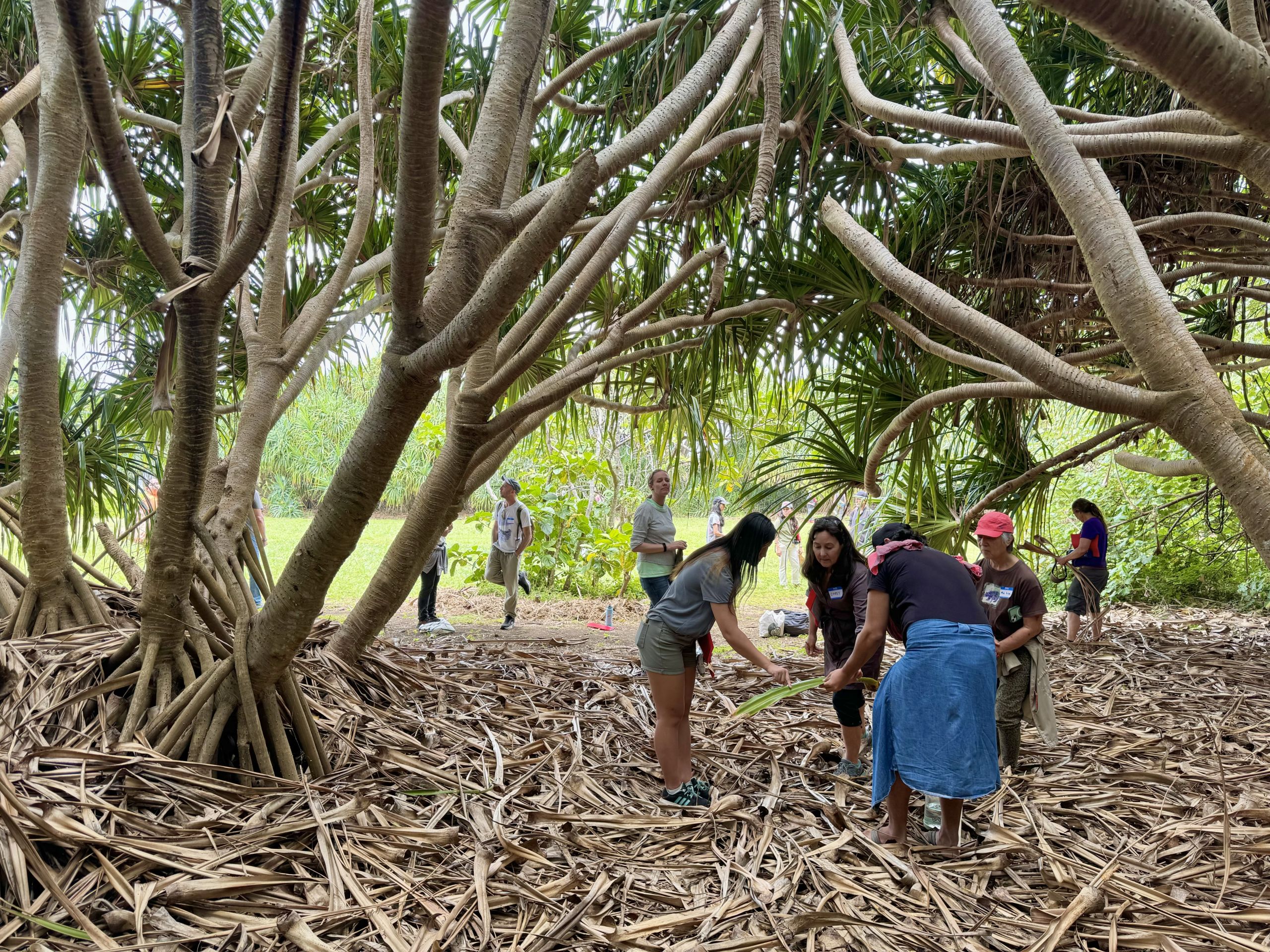Weaving Diverse Knowledge of a Climate Resilient and Culturally Significant Plant on Hawaiʻi Island
June 11, 2025

The hala tree, or Pandanus tectorius, has significant cultural, ecological, and economic value in Hawaiʻi and all across Oceania. Different parts of the hala tree are used for weaving, thatching and shelter-building, lei-making, dye, medicine, and food. Sails woven from lauhala (pandanus leaves) harnessed the wind that carried Polynesian navigators to the islands centuries ago. The weaving of lauhala, or ulana lauhala in Hawaiian, was a key cultural skill and daily practice in the lives of Native Hawaiians over many generations and spanning hundreds of years. From an ecological lens, research has also pointed to hala’s potential role in climate adaptation and resilience by protecting shorelines from erosion, inundation, and storm-induced flooding, and acting as a barrier from salt spray to crops growing near the coast. However, native coastal forests of hala are now considered rare in Hawaiʻi. The practice of ulana lauhala has also seen a decline over many recent decades, but has experienced a revival and continues to grow through a younger generation eager to learn. Could the perpetuation of weaving practices, and the care of hala that goes along with it, lead to an increase in abundance and health of hala groves, and therefore increased climate resilience, across Hawaiʻi?
A project funded by the Pacific Islands Climate Adaptation Science Center (PI-CASC) is studying these potential connections.
The project encompasses community collaborations and co-created research on the ecological resilience, history, traditional practices, and distribution of hala across Hawaiʻi Island. It has brought together collaborators from multiple disciplines and includes scientists, researchers, natural resource managers, cultural practitioners, educators, students, and artists. Over the course of a year during monthly co-learning sessions, groups of 20-30 participants explored a range of topics such as hala grove stewardship, Native Hawaiian knowledge and practices for cultivating and processing lauhala for weaving, economic opportunities and challenges, and sustainable use of hala materials.
“The co-learning sessions have been generative, and new lines of inquiry, methods, and collaborations have been emerging,” says Udi Mandel, co-principal investigator on the project and co-founder of the Enlivened Cooperative. “Participants have been developing relationships and sharing their knowledge and practices around hala.”

Master weaver and participant, Duncan Kaʻohu Seto, is a kumu (teacher) and advocate of the reemergence of ulana lauhala. At 71 years old, he’s been weaving since the 1980s, but acknowledges that even for him, there is always more to know.
“If you do it long enough, people start calling you a master, but to me, I am still learning. I don’t know everything,” says Kaʻohu, adding that “there are different styles, different kumu, and they teach different things. So I always keep an open mind.”
The groups gathered in spaces on Hawaiʻi Island where hala groves and ulana lauhala thrive, adhering to cultural protocol throughout interaction and engagement with both the hala and with each other. A key participant in this project has been the hala trees themselves. A question that emerged and resonated with participants as they explored their relationships with hala was, “What does hala want?”
“This de-centering of the human subject as the only possible site of agency and the embrace of hala as a subject and agent in the world, as was always the case in Hawaiian culture, provokes us to re-think our role as caretakers and stewards for the flourishing of hala for generations to come,” said Mandel.
A diverse body of knowledge surrounding hala was formed through an emergent process of learning and collaboration, culminating in a visual exhibition of science, skill, and creativity.
Science and Traditional Knowledge Integrated Through Art and Weaving
On May 9, 2025, the first public output of this project was on display in a gallery exhibition at the Wailoa Art Center in Hilo. An intersection of art, science, technology, and ecology, the exhibition, simply titled “Hala”, features pieces created by 16 project participants that showcase different stories and perspectives of hala in Hawaiian history and culture, what the future could look like for hala grove resilience, and perpetuating the knowledge in caring for them in an age of climate change. These themes are expressed through various mediums, including weaving, photography, video, a sensory experience with different parts of the hala tree, conceptual and interactive art, and lauhala-woven toy bots. The exhibition will continue at Wailoa Art Center through June 19.
Mapping Hala for Resilience and Stewardship Opportunities

Along with its cultural significance, hala’s ecological value is inherent in its ability to thrive in environments considered harsh to most other plants. It has a high tolerance to drought, sea salt spray, and periodic saltwater inundation, and is adapted to a wide range of soil types. Its sturdy aerial prop roots and ability to anchor itself in challenging soils help to bind sand, prevent erosion, and stabilize sandy soil along coastal and beachfront properties. They can also function as a windbreak, helping to protect coastal crops from salt spray.
Justin Kellum, another participant in this study, is a geospatial analyst and educator specializing in GIS, remote sensing, and environmental justice. He seeks to empower local communities in their care for hala, illuminating the tree’s deep connection to place, while strengthening conservation efforts and supporting weaving practices. As part of his work and contribution to this project, Kellum has mapped the historical, contemporary, and projected future distribution of hala across Hawai‘i Island to gain an understanding of where it may be more resilient to climatic shifts and impacts from sea level rise.
Additionally, surveys and interviews with businesses and hala practitioner networks will inquire as to access, sourcing, and costs of hala, the time and labor involved in processing and weaving lauhala, markets in Hawaiʻi and beyond, and perceptions of future opportunities. The practical and economic mapping activities will help depict major patterns and themes from the work, analyzing relationships between research components. For example, hala groves primarily associated with economic activity may have higher health, or certain stewardship practices may be associated with certain patterns of hala growth or health.
Perpetuating Knowledge of Ulana Lauhala and Hala Grove Stewardship
The project will conclude with a catalogue of diverse knowledge systems, methods of hala stewardship and preservation, sustainable use of hala products, mapping integration, and threats and opportunities for reforestation. Cumulative outputs will provide natural and cultural resource managers and policy makers with the science and traditional knowledge-based tools for understanding broader climate challenges the island is facing, and specific steps that can be taken to mitigate and adapt to these through hala stewardship and regeneration.
During one co-learning session, one of the expert weavers asked, “How can we continue with this Hala Hui (group) after this project?” Mandel sees a desire to further this knowledge, learning, and research around hala, and says that participants “have begun to think through what this collective work could look like beyond this project.” This includes developing a proposal for STEAM learning with hala, hosting the exhibition on other islands, exploring ways that hala can be reforested to protect coastal regions, and seeing how the work of expert weavers can be further supported to pass on their knowledge and practices to the next generation.

